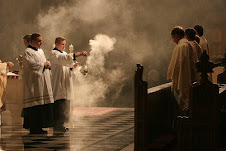 It was a simple text message from a good friend on the
anniversary of my sister’s death that read, “My prayers are with you and your
family today.” I responded very simply,
“Thank you for your prayers and thanks to Him for the many graces
received.” The dialogue continued, “I
know the first year of mourning can be very hard, but there is something
different and special about the thirteenth month.” And as readily as this verbal exchange with a
dear friend came into view, it easily faded into the periphery.
It was a simple text message from a good friend on the
anniversary of my sister’s death that read, “My prayers are with you and your
family today.” I responded very simply,
“Thank you for your prayers and thanks to Him for the many graces
received.” The dialogue continued, “I
know the first year of mourning can be very hard, but there is something
different and special about the thirteenth month.” And as readily as this verbal exchange with a
dear friend came into view, it easily faded into the periphery.
Later that next month I visited with one of my surviving
sisters at her family home. It was a
simple visit with some common hospitality that a dear sibling would offer. She said, “Can I get you anything?”
I was already at the coffee machine. In the kitchen there was one of those modern one-cup
gizmos that offered convenience, selection and the tidiness of coffee and
filter in a simple and tidy little package.
I saw next to the coffee machine that there was another rotating “gizmo”
for putting the unused “k-cups” on display.
There were only four or five of these there, most of the slots in the utensil
lay empty.
I paused for a moment, unsure why. “There is more coffee in the garage if you
want”, said my sister from the adjoining room.
I ambled over to the garage and found the box of coffee as I expected to
see it: more of the same “flavor”. You
see, my sister and brother-in-law embrace simplicity of life when it comes to
coffee. You can have what they have but
one should not hope for the cornucopia of flavors and styles that most purveyors
of k-cups offer. I knew this but I went
into the garage anyway, still unsure why.
What came next seemed quite natural, but was an unexpected
surprise. I would say that what occurred,
upon further reflection, was perhaps the awareness of some profound grace in
operation.
I removed the box of coffee and brought it into the
kitchen. Carefully, I filled all the
empty circles of the gizmo with new, fresh k-cups. For some reason I did this simple exercise
very meticulously, with care and with love.
Once the coffee was brewed my sister returned to the
kitchen. She, the Catechist and “soccer”
Mom is a master of tasks. I would not have
been surprised that day if in my absence she accomplished much. Typically, she responds to emails whilst
directing homework whilst conversing both on the phone and with one of her
children. These things would have been
no surprise to me then because many times this mastery of multi-tasking happens
in my presence. This is simply standard procedure
in her lovely but busy household.
Our conversation continued quite naturally in the kitchen. I was gazing at one of her many pictures of
our eldest sister, Patricia Ann. Trish
died just thirteen months before and was the subject of the text message I
received earlier. Like the many pictures
of her that adorn our walls and coffee tables, she was smiling. I asked very humbly, “Do you think it would be
true if I said Trisha smiled more in the last years of her life than the rest
of her life, altogether?” My sister
replied, “Yes, without a doubt”. The
photo that my sister and I were looking upon at that moment provided testimony
to this: the ever smiling Trish, fatigued by disease but glorious in her
embrace of life as seen in her ever widening, beautiful smile.
Trish died of cancer after a heroic two and a half years
struggle with the terrible disease. Yet
my favorite photo of her is the one that I am sure she wanted us to have the
most. She is smiling, ear-to-ear with
eyes alight, sitting up in her hospice bed.
It was taken literally hours before she breathed her last breath.
I returned from my ruminations to my youngest sister
standing with me in her kitchen, steaming hot coffee cup in my hand. She was off and back multi-tasking again
while I drifted. I looked at her and asked
rhetorically, “Do you realize what I just did?” I continued, “I went into the
garage to get more coffee to fill your dispenser.” She smiled as I continued further. “That was so Trish!” Quietly, she said,
“I know.” We both smiled, noting the moment of grace ever present in our
hearts.
There is something special about that thirteenth month. This suggestion from my friend and her text is
worth a closer look.
After my sister’s death, I would say there was a real lift,
an emotional consolation that was very real.
It was grounded in the intellectual understanding that she no longer was
suffering with the disease. Sure, we
hoped she would survive and “beat” the prognosis of stage-four cancer and many
of us were also praying for a miraculous healing. Nonetheless after her death there was
emotional relief for us who loved her so very dearly.
However, spiritual consolation takes some time, time that
sometimes we are unwilling to give. We
must embrace mourning, and if we look towards our Lord and Master for help we
are consoled with his words. “Blessed
are those who mourn, for they will be comforted” (Mathew 5:4). We would be doing well to heed to His
teaching.
Father Robert Barron in his Catholicism series (1) offers, perhaps a more appropriate English translation of the original Greek than that of Saint Matthew. Barron asks that we substitute
“Happy” for “Blessed”. He explained that
true happiness; in fact a disposition towards gratitude steeped in grace
directed towards the Creator is necessary for consoling grace. Fr. Barron suggests that this can be attained
by practicing the Beatitudes in a way that which Jesus wants us to. Therefore his translation would read, “Happy
are those who mourn, for they will be comforted.”
When we are willing to enter into the mystery of the
Incarnation through a historical lens we learn that as a Jewish man Jesus knew
the tradition of formal mourning well. It
was not simply an emotional reaction to loss, but a deep cultural practice
steeped in the expression of their Jewish faith.
Then, as now in the Orthodox Jewish communities, mourning
had at least three distinct stages: immediate, proximate and remote.
First the immediate family would sit shivah (2)
for the first week after the burial.
They would cease any regular activity, including work, cooking and
formal mealtimes. Consolers would come
to their house and “sit” with them in their bereavement.
Next would be the remainder of the first month. They could return to work, but clearly they would
continue their morning. Perhaps they
would remain wholly or partially in black clothing and they would be granted a
certain liberty to come and go to work as they willed.
Finally, for the remainder of that first year of mourning they
would ease back into normal routines, always expressing in some manner their
loss. This could be verbally as well as
other ways within their community while at worship. The year would end with a memorial liturgy to
close out formally the period of bereavement.
I think we can take a page from our elder brothers and
sisters of the Judeo-Christian tradition.
When we do so, we may be surprised by the graces we receive. Another benefit is to truly be of the world,
but not in the world (Jn 17:14). This
can be naturally challenging in a society that seeks instant gratification at
nearly every turn.
If we submit to the
“world”, than we are being told something very different than what we need to hear, that patience is necessary to truly grieve the loss of a loved
one. Our prudential judgment then should be to listen
and pray over the words of the Beatitudes. They can teach us not only to desire these
available graces, but to strive for them.
Fr. D.A. Suglia
sscm.sacrprep@gmail.com
-------------
http://en.wikipedia.org/wiki/Shiva_(Judaism)













No comments:
Post a Comment